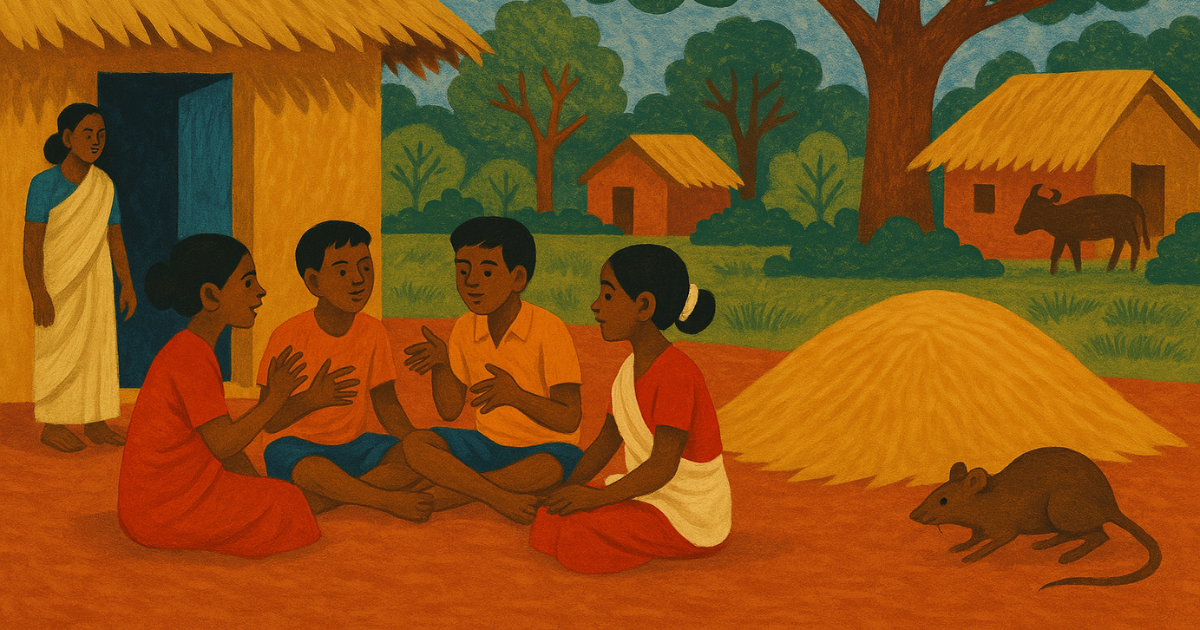The Morning of Many Rats
In a Santhal hamlet on the Sagardwip island, West Bengal, I once sat with a group of children as they played near a storage of paddy. When the conversation turned to rats, they began to recite names: one for the rat that gnaws through sacks before sowing, another for the rat that raids harvest piles at night, a third for the rat that follows people indoors, and yet another for the rat that flees to higher ground when the monsoon swells.
These were not synonyms but situational categories, each tied to an encounter. Each name captured a relationship: a rat as thief, a rat as omen, a rat as neighbor who shared the granary. What textbooks collapsed into a single word, rat, the children unfolded into an ecology of presence and consequence.
I realized then what Scott Atran and Douglas Medin have called the universals of folkbiology: that humans everywhere sort living beings into kinds, but the texture of those kinds depends on practice and culture. The Santhali children were not simply naming rodents; they were mapping a world of relations.
Universals and Their Discontents
Cognitive scientists remind us that across cultures, people naturally form “generic species” categories: sparrow, oak, salmon. Darwin himself remarked that such groupings “are not arbitrary like constellations.” Yet these universals, Atran and Medin warn in The Native Mind and the Cultural Construction of Nature (2008), are not destiny.
They require cultural scaffolding: rituals, work, stories, and apprenticeship. Remove children from direct contact with the living world, and universals collapse into hollow labels. The word survives, but the relations perish. A rat becomes a pest control image in a classroom chart, stripped of its multiple faces.
The authors call this process devolution. In industrial societies, children may know hundreds of Pokémon species but cannot name ten local trees. Knowledge devolves not because minds have changed but because worlds have.
The Diverging Lexicons of Shared Valleys
Years later, in Maharashtra, I spent time with the Thakars, Mahadev Kolis, and Katkaris; three Adivasi communities who have lived in overlapping geographies of forest, hill, and field. They share terrain and rainfall, but their vocabularies reveal different histories.
The Katkaris speak from inside the forest; their terms enfold bark, resin, and leaf into single acts of dwelling. A tree is not merely timber but a companion in hunger and in healing.
The Mahadev Kolis and Thakars, more settled into semi-agrarian life, carry words that straddle the edge between foraging and farming, as their lexicon reflects granaries and terraces as much as streams and groves.
Here, again, the cognitive universals were shared. Everyone knew what a rat, a mango tree, or a parrot was. But the distribution of words, and the meanings they bore, diverged with ways of life; three maps of one valley, each charting obligations differently.
Children of Moss and Birds
In Arunachal Pradesh, I met schoolchildren who could distinguish bird calls with a precision my ear could not match. They spoke a language in which ecological vocabulary was abundant and fine-grained.
Yet in school, this richness was not rewarded. Their textbooks asked for the singular answer, the “one bird species.” Children edited themselves into silence. The living lexicon remained at home while the school installed a narrower one.
Here, devolution took a subtler form. It was not yet the disappearance of knowledge but its delegitimization. When a child learns that her grandmother’s word for a bird or a plant has no place in the classroom, she learns not just about birds or plants but about which ways of seeing count.
Culture as Distribution, Not Essence
Anthropology has long wrestled with what “culture” is. Atran and Medin argue against treating it as a fixed essence or a superorganism. Instead, they describe culture as a distribution of ideas across populations. Knowledge spreads not by perfect replication but by fragments, which people reconstruct using prior cognitive structures.
This explains why Santhali children can name rats with precision while their urban peers cannot; the difference is not in cognitive universals but in the cultural distributions that channel them. One world makes the category rich, another hollows it out.
It also explains why the Katkaris, Thakars, and Mahadev Kolis, despite sharing geography, carry different ecological vocabularies; their practices have canalized different distributions.
When Words Disappear, Relations Do Too
Language is not merely a mirror of the environment but a practice of attention. Robin Wall Kimmerer, the Potawatomi botanist and writer, reminds us that “to be native to a place is to live as if your children’s future mattered.” Naming, in her world, is an act of reciprocity.
When children lose names for beings, they lose scripts for relating. A rat is no longer a thief to be managed or an omen to be read; it becomes a nuisance to be exterminated. The shift is not trivial as it alters ethics and narrows imagination.
Eduardo Kohn, in How Forests Think (2013), suggests that forests themselves are semiotic systems, communicating through signs. If children are deaf to those signs, the forest ceases to be a partner. It becomes a backdrop.
When “Save the Tiger” Replaces Knowing the Crow
Modern schooling prides itself on spreading scientific awareness, yet its obsession with standardization often accelerates the very ignorance it claims to cure. Local vocabularies are dismissed as folklore, community calendars as superstition, children’s observations as anecdotes. In the process, the ecological imagination is thinned into slogans.
The irony is glaring. A child can stand in an assembly hall and chant “Save the Tiger” with conviction, yet when asked to identify the sound of a koel or a crow outside the window, she falters. She can draw the carbon cycle with textbook precision, yet cannot say which tree on her street is the first to flower each summer. Nature becomes a concept to be preserved, not a companion to be noticed.
This hollowness is not incidental. By erasing local knowledge from classrooms, schools produce a generation fluent in abstractions but estranged from experience. Environmental education turns into a parade of charts and projects, performed as a civic duty rather than a lived practice. The forests and rivers become topics for PowerPoint slides, not neighbors with claims on our attention.
Atran and Medin’s work underscores what traditional communities have long known: sustainability depends not only on facts but on values. Sacred groves and tabooed ponds are not relics of superstition; they are anchors of restraint. When conservation is reduced to calculations of cost and benefit, it collapses into mere management, easily abandoned when profit dictates otherwise. The lesson is clear: without the grammar of values, knowledge alone does not teach care.
What Schools Could Do
How, then, might modern education respond?
- Build Living Glossaries: Every school can curate a glossary of local species, with names in home languages, regional lingua franca, and scientific Latin. These glossaries should be seasonal and experiential, updated as children encounter new forms.
- Draw Seasonal Calendars: Children can map the year not only by months but by cycles of flowering, rainfall, migration. Calendars that train observation and embed science in lived rhythms.
- Practice Apprenticeship: Short-term learning with farmers, potters, fishers, and seed-savers can bring technique and ecology together. Science lessons then build upon these apprenticeships.
- Honor Sacred Values: Schools should recognize local taboos and rituals around trees, rivers, and animals as ecological reasoning, not superstition. This fosters respect for restraint.
- Reimagine Assessment: Instead of testing only recall, evaluate portfolios of attention: sketches, weather logs, interviews, seasonal diaries.
Such measures would not weaken science. Instead, they would prepare students to meet science as an ally of their own traditions of noticing.
The Politics of Legibility
James Scott, in Seeing Like a State (1998), warned that states flatten local knowledge in order to make it legible for administration. Schools do something similar when they replace diverse ecological vocabularies with uniform categories. The result is a landscape of ignorance that looks like clarity on paper.
The tragedy of devolution is not simply that words are lost. It is that the very resources needed to live sustainably, diverse ways of perceiving and valuing the world, are erased in the name of standardization.
Toward an Education of Attention
Tim Ingold has written of “education of attention”; learning that is less about information transfer and more about cultivating the eye, the ear, the hand. Environmental education, if it is to matter, must be an education of attention.
Attention to the multiple names of a rat. Attention to the moss that cushions the soil. Attention to the bird that calls at dusk. These are not distractions from science. They are its necessary conditions. Without them, the abstractions of ecology float unmoored.
Closing: The Responsibility of Naming
I often return to that morning in Sagardwip. The Santhali children’s names for rats were not romantic but practical, tied to their survival. Yet they carried a poetics of relation. Each name acknowledged a neighbor whose presence demanded ingenuity and restraint.
When a child learns to name in this way, she is also learning responsibility. To lose such names is to lose a grammar of care.
Atran and Medin remind us that culture is not essence but distribution. It is not permanence but practice. If schools become places where ecological vocabularies are silenced, they will preside over the narrowing of the human imagination. If schools instead learn to carry the many names of rats, they will help raise a generation that can stand in the world with humility, precision, and care.
The choice is ours: to educate for categories emptied of relation, or to educate for relations that can sustain life.







